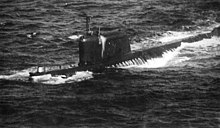Nikolai Vladimirovich Zateyev
Nikolai Vladimirovich Zateyev | |
|---|---|
Russian SFSR, Soviet Union | |
| Died | August 28, 1998 (aged 72) Moscow, Russian Federation |
| Allegiance | |
| Service/ | |
| Years of service | 1943–1986 |
| Rank | Captain First Rank |
| Commands held | K-19 |
| Awards |
|
| Other work | Author |
Nikolai Vladimirovich Zateyev (
Early life and career
Zateyev was born in
K-19

On July 4, 1961, while K-19 was operating near southern Greenland, water pressure in the starboard nuclear reactor plummeted due to a coolant leak in an area of the reactor very difficult to access. The loss of coolant caused the reactor to begin to overheat, endangering the integrity of the control rods. Zateyev mistakenly believed this could lead to a nuclear explosion.[5] The captain believed that such an explosion would damage a nearby NATO base and could cause a nuclear war between the Soviet Union and the United States. Mikhail Gorbachev later wrote that "An explosion on board the K-19 could have been taken for a military provocation or even an attempt to launch a nuclear strike on the North American coast. An immediate response by the United States and NATO could have triggered off a Third World War."[5] Eight crewmen died in the days that followed July 4, after working in the reactor core.[1] However, a jerry-rigged coolant system successfully averted any catastrophe. The K-19 was later towed back to harbor and its reactors were replaced over a period of two years.
Following the incident, Zateyev and the crew were instructed to keep silent about the accident, and neither the replacement crew for the K-19 nor the families of those who had died were notified. The victims of radiation poisoning were buried in lead coffins at sea, according to the letter written by Mikhail Gorbachev to the Norwegian Nobel Committee in 2006. Only in 1990 were the survivors (of which there were 56 by February 1, 2006) permitted to speak.[5]
Zateyev was subsequently employed on shore. From 1962 to 1965, he studied at the
In popular culture
The character Captain Alexei Vostrikov played by Harrison Ford in the 2002 film K-19: The Widowmaker is heavily based on Zateyev.
Notes
- ^ a b Studios Fight To Tell Story of Submarine Archived 2014-12-24 at the Wayback Machine The St. Petersburg Times, retrieved August 9, 2007
- ^ K-19: Doomsday Submarine IMDb retrieved August 11, 2007
- ^ Interview With Peter Huchthausen CNN retrieved August 11, 2007
- ^ National Geographic K-19 The History: 1958-60: The Construction of K-19 Archived 2009-03-25 at the Wayback Machine retrieved August 11, 2007
- ^ a b c d Gorbachev Proposes Soviet Sub Crew For Nobel Peace Prize Federation of American Scientists retrieved August 11, 2007
